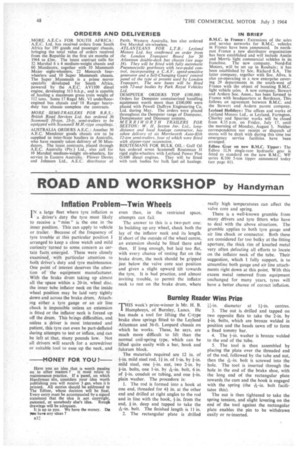ROAD AND WORKSHOP by Handyman
Page 50

If you've noticed an error in this article please click here to report it so we can fix it.
Inflation Problem Twin Wheels
IN a large fleet where tyre inflation is 1 a driver's duty the tyre most likely to receive a "miss" is the one in the inner position. This can apply to vehicle or trailer. Because of the frequency of tyre trouble at this particular position I arranged to keep a close watch and mild curiosity turned to some concern as certain facts emerged. These were closely examined, with particular attention to both driver's duty and tyre maintenance. One point of interest deserves the attention of the equipment manufacturer. With the brake drum taking up almost all the space within a 20-in, wheel disc. the inner tube inflator neck on the inside wheel position may be laid very tightly down and across the brake drum. Attaching either a tyre gauge or an air line chuck is impossible unless an extension is fitted or the inflator neck is forced up off the drum. This brings difficulties, and unless a driver is most interested and patient, this tyre can even be part-deflated during attempts to test or inflate, and can be left at that, many pounds low. Not all drivers will search for a screwdriver or suitable tool to ease up the neck, and
even then, in the restricted space, attempts can fail.
The answer to this is a two-part one: In building up any wheel, check both the lay of the inflator neck and its length. If short of the outside of the wheel centre, an extension should be fitted there and then, If long enough, but laid too flat, with every chance of resting flat on the brake drum, the neck should be gripped just below the valve core seat position and given a slight upward tilt towards the tyre. It is bad practice, and almost inviting trouble, to permit the inflator neck to rest on the brake drum, where
really high temperatures can affect the valve core and spring.
There is a well-known grumble from many drivers and tyre fitters who have to deal with the above situations. The grumble applies to both tyre gauge and air line chuck or connector. Both these are considered far too bulky at the fitting aperture, the thick rim of knurled metal very often defeating all efforts to locate on the inflator neck of the tube. Their suggestion, which I fully support, is to streamline both gauge and air line attachments right down at this point. With this excess metal removed from equipment unchanged for many years, tyres will have a better chance of correct inflation.












































































































































